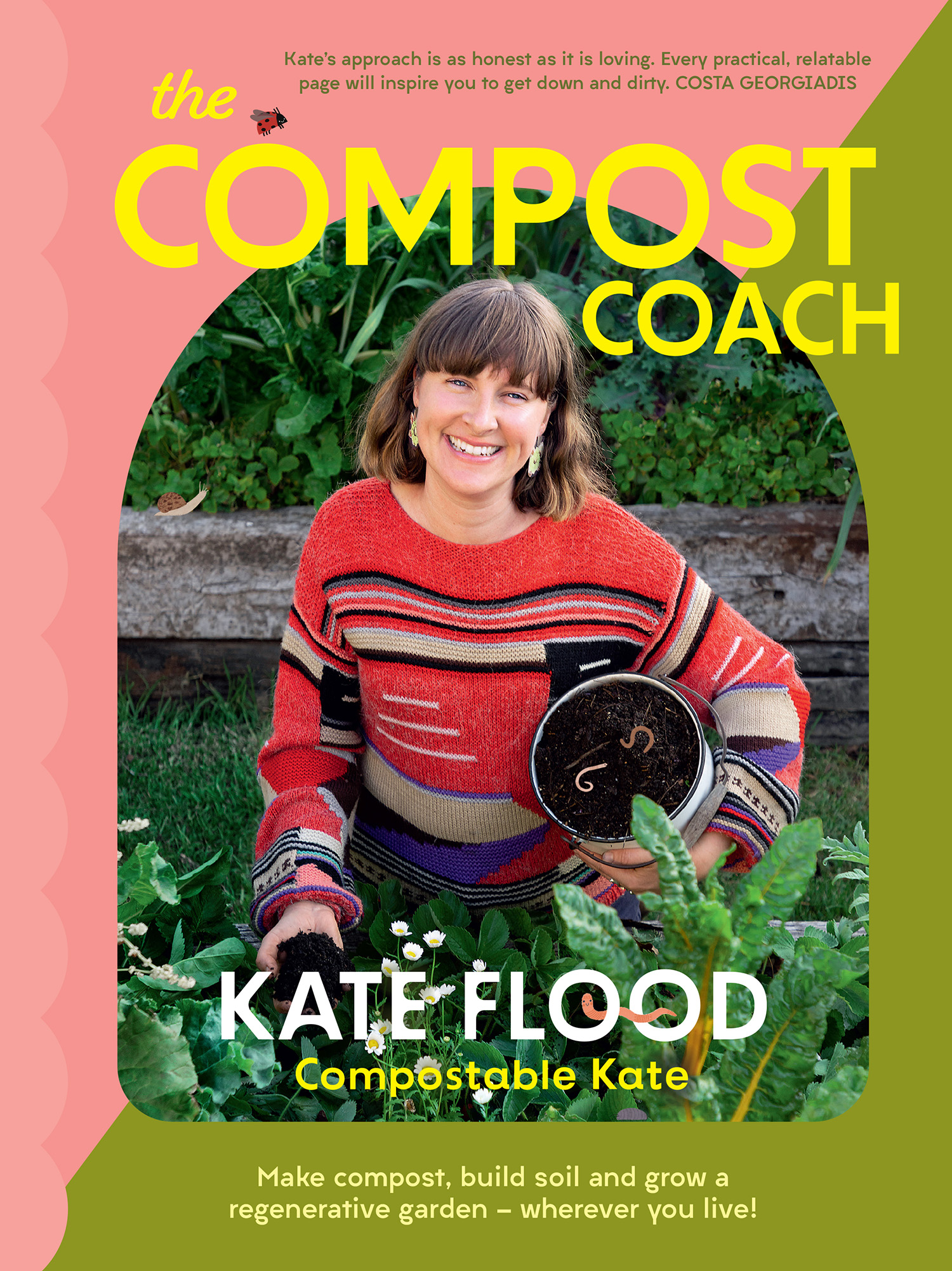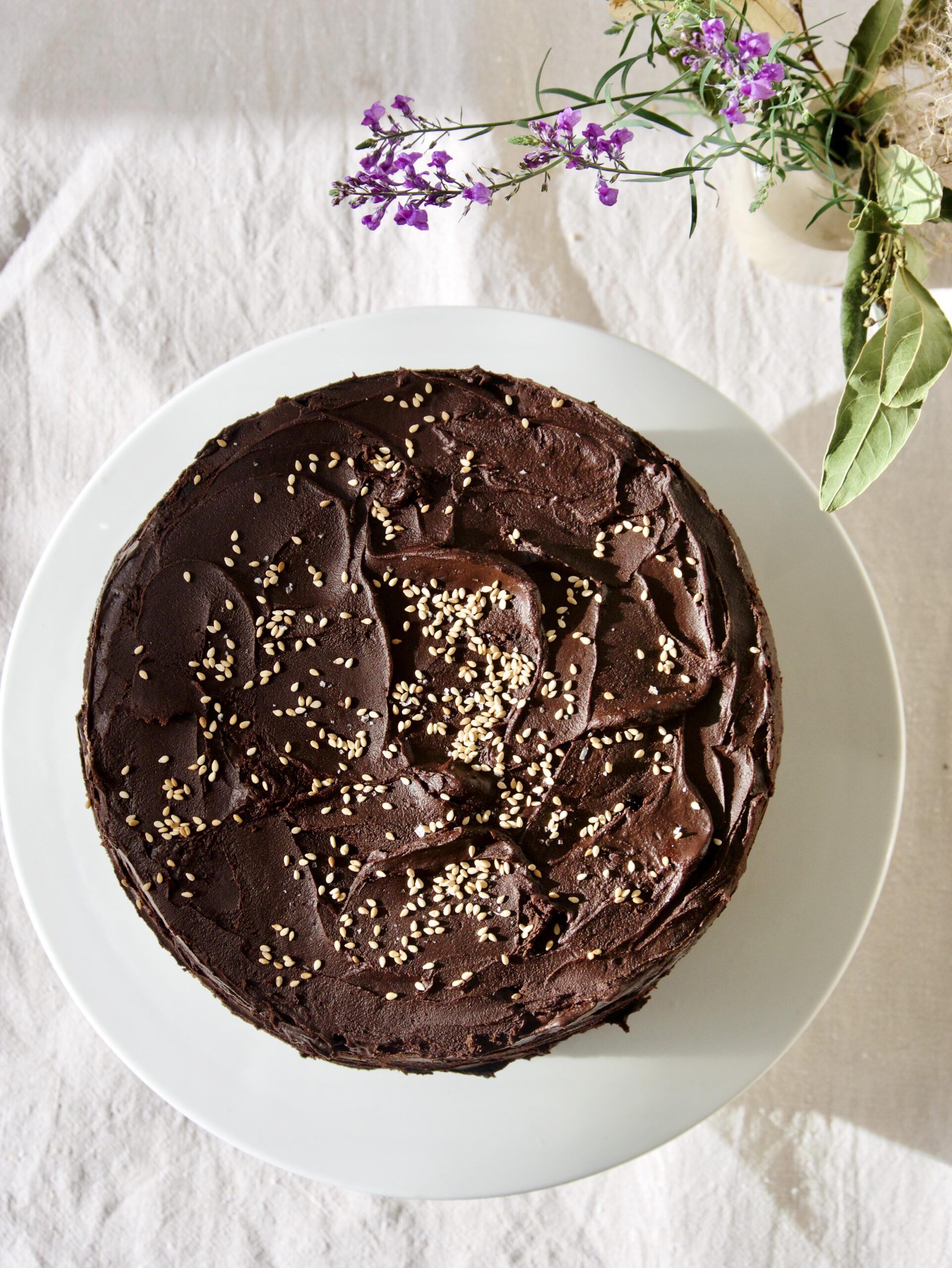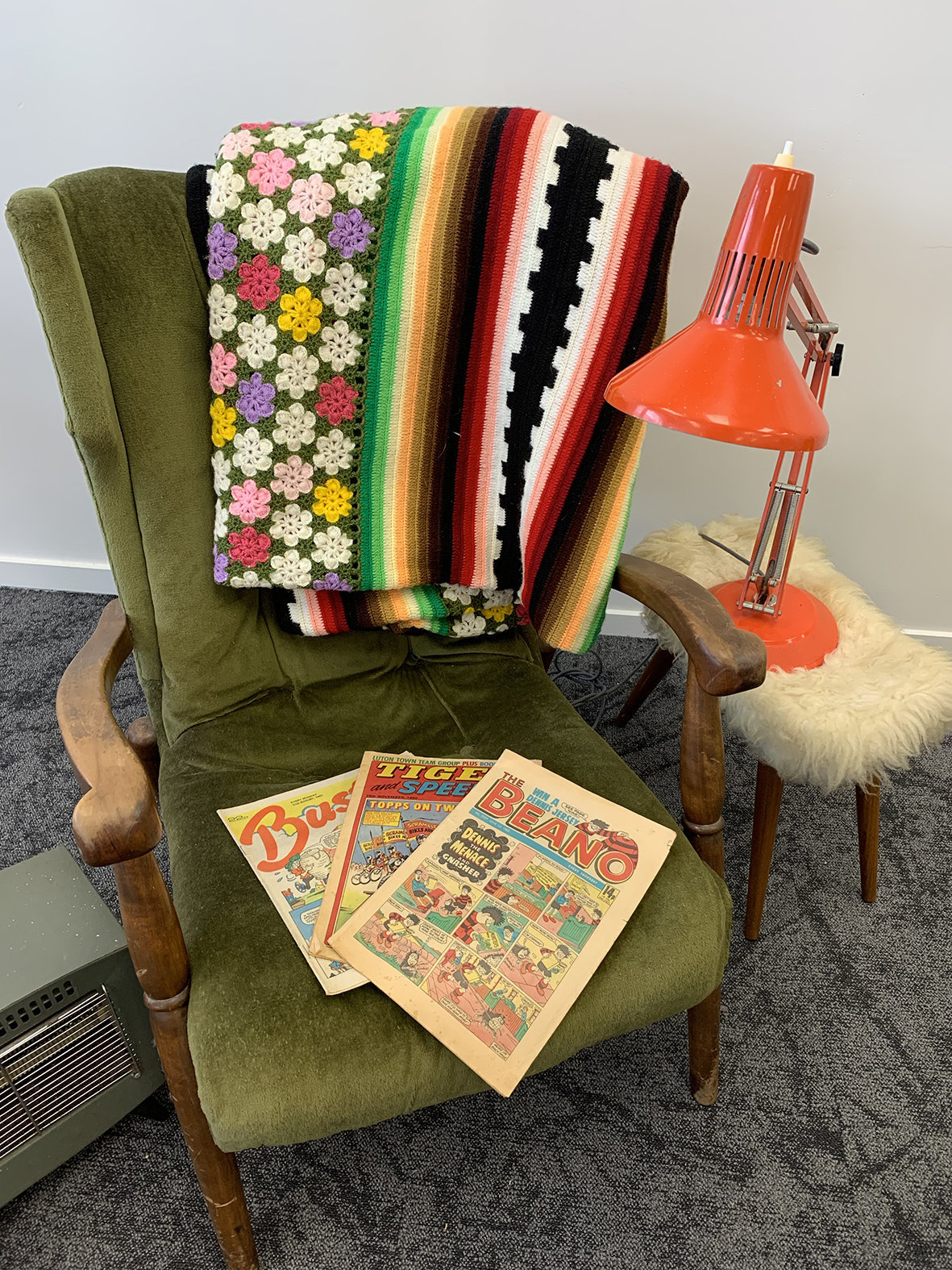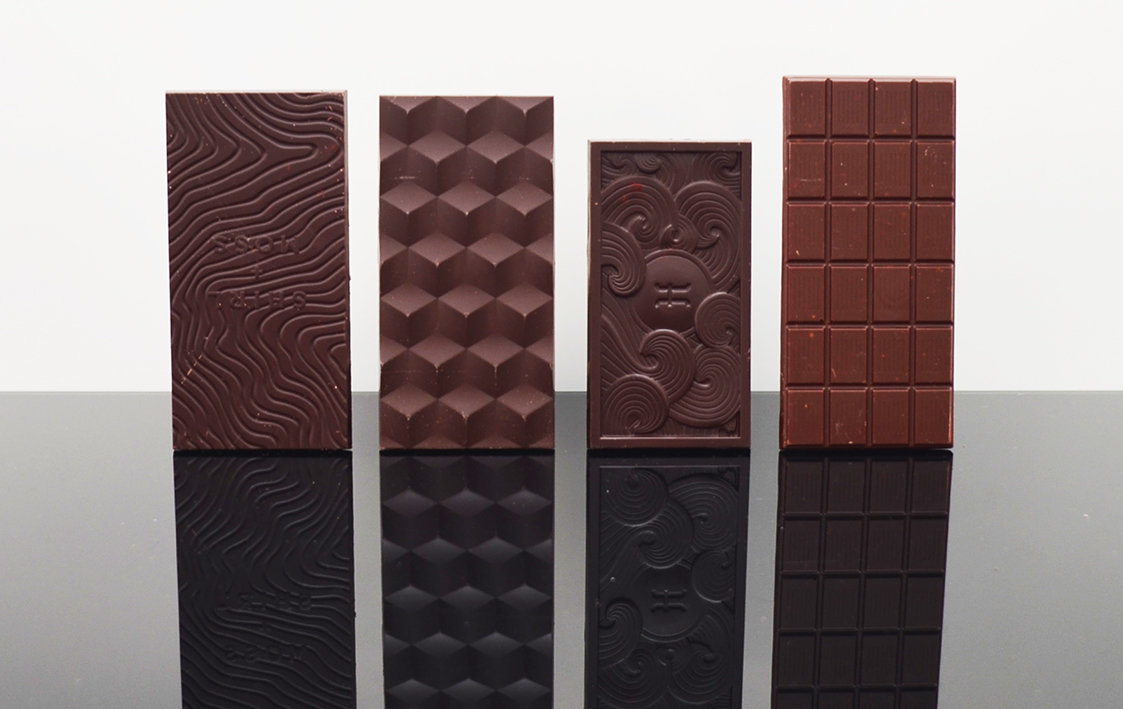Words Kate Flood. Photography Honey Atkinson.
Kate Flood aka Compostable Kate is happiest when she’s teaching people about compost or is elbow deep in the stuff. She’s a compost nerd and sustainability educator, and she’s on a mission to help others step-up their household waste management.
Her book, The Compost Coach, is a guide to creating the very best compost and is pitched at the home composter, including people who live in apartments and houses with or without gardens (yes, you can compost without a garden!).
She explains what compost is, what it does and how to slow compost, which is just one of the many ways to do it.
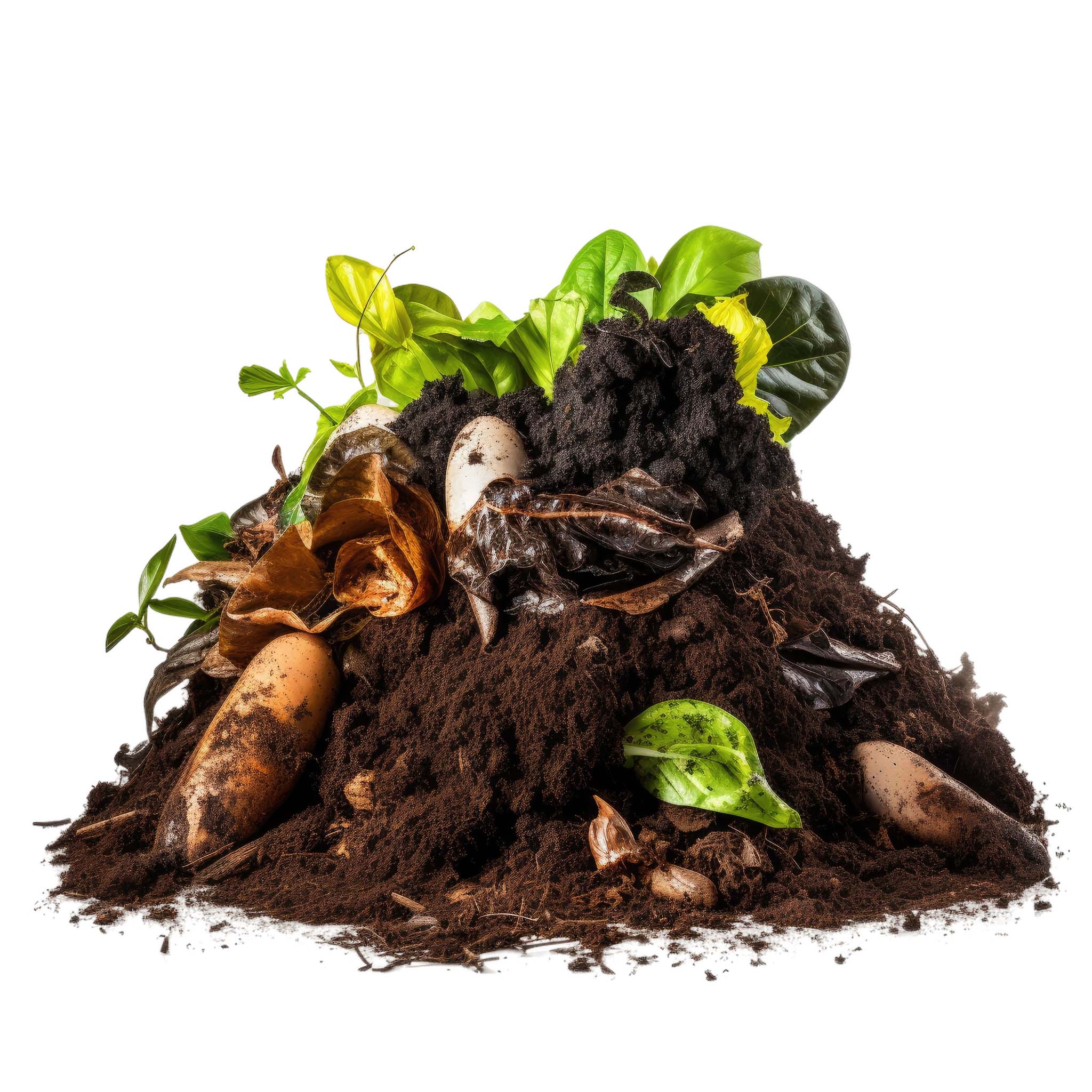
What Is Compost?
Composting is a microbial-driven process of decomposition. It turns organic matter into a valuable amendment that feeds the life in your soil. To put it more simply, compost is the transformational process that turns ‘waste’ into a resource. It’s real-life alchemy – changing scraps into black gold.
Something that may seem obvious but is actually quite reassuring to anyone who has attempted to make compost is that compost happens every single day in nature without human intervention. Pull back the leaves on a forest floor, and you’ll find the most fabulous decomposing organic matter, heaving with worms and life. Compost in nature never follows an exact recipe. One season, it may be full of fallen leaves with welcome additions of berries, pinecones and manure dropped from passing animals. The next season, it could have the carcass of a dead animal and the branch of a fallen tree.
Anything that was once alive decomposes eventually. Backyard composting simply speeds up the process by providing the perfect environment for bacteria, fungi and other organisms (such as worms, beetles, slaters and beneficial nematodes) to do their work. Regardless of whether it’s you or Mother Nature making it, compost requires four universal elements: nitrogen (the juicy stuff), carbon (the dead, dry stuff), oxygen and water. I’ll talk about these in detail later, when I show you how to make stellar compost.
What Is Organic Matter?
Organic matter is an umbrella term for any living or dead animal or plant material. Here are some examples of organic matter: fresh green leaves or fallen brown leaves; an animal carcass – bones and all – from your cooking (hello, roast chicken!) or, more gruesomely, from roadkill; woodchips or a whole branch of a tree; commercial pelletised chicken manure or cow (or human!) manure; freshly pulled weeds; and dried straw. Organic matter comprises the raw materials that can be transformed into compost.
What Does Compost Do?
Compost builds healthy soil. If you become a compost creator rather than just a plant cultivator, you’ll eventually be able to wean yourself off using artificial fertilisers as well as toxic pesticides and herbicides. This is because compost feeds the life in your soil, which grows strong plants, and this helps to build a healthy ecosystem in your own backyard.
Shop-bought fertilisers never fix poor soil; they provide a temporary band aid solution but ultimately kill off soil biology. If your garden doesn’t have a thriving soil food web (this term is used to describe what eats what’s in your soil), then your plants will become more susceptible to pests and diseases. This leads to an increased use of pesticides and herbicides that indiscriminately kill everything they land on: the harmful pests and the beneficial pollinators, predators and biology in your soil. This quick-fix style of gardening may seem like an easy solution, but it creates more problems that you’ll have to deal with in the long term.
When you become a compost creator, you may find yourself becoming more tolerant of a background population of pests in your patch. You’ll start to realise that pests are part of the food chain and help to sustain the beneficial predators and pollinators we all know and love – hello, gorgeous ladybirds, lacewings and praying mantises, not to mention all of the microscopic life forms in your soil that protect your plants, too. If you learn to live with all sorts of bugs in the soil and on your plants – the cute, the annoying and even the icky – then you’ll notice the natural balance of your patch developing.
How To Make Slow Compost
Follow these instructions to achieve beautiful results in a plastic compost bin, box or open pile. I’m giving you all of the details about each step so you can confidently do this at your own place.
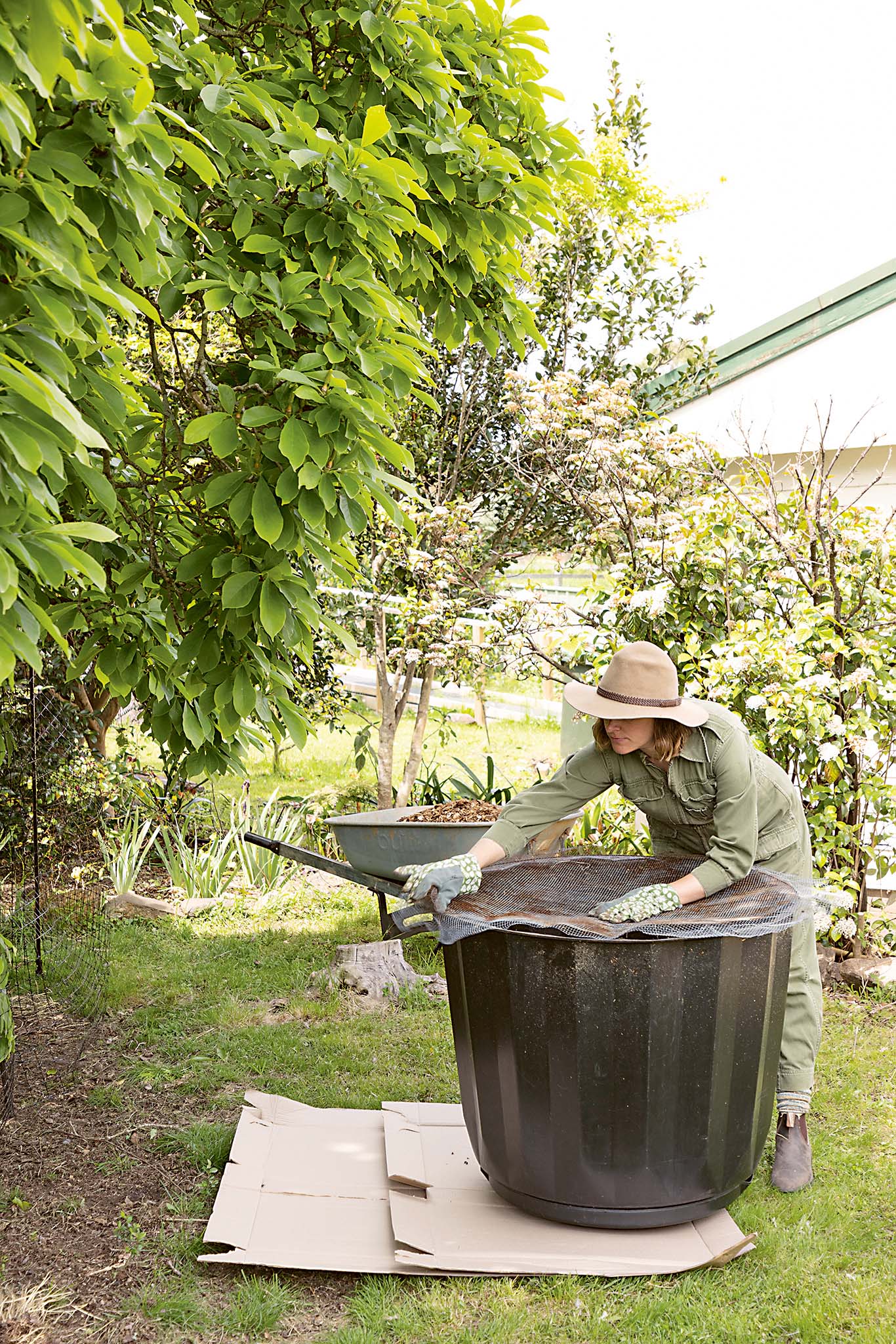
1. Set up your compost pile directly on the soil or lawn. If it’s an invasive species, such as kikuyu, cover the grass with cardboard to smother it, and pile your compost on top of this. If working with a compost bin or box with an open base, apply a piece of rodent-proof, stainless-steel mesh to the bottom.
2. Start with a 15cm layer of carbon. I like to use chunky woodchips for this foundation layer because air is captured between them; they also help with drainage and act like a sponge to suck up any excess moisture. Fungi love woodchips, too, so it’s a win-win situation. Alternatively, you can use twigs, bark or even stalks from brassicas or corn mixed with softer carbon sources (such as ripped cardboard or fallen autumn leaves). It’s important to use a combination of structural and soft carbon so the foundation layer doesn’t decompose too quickly.
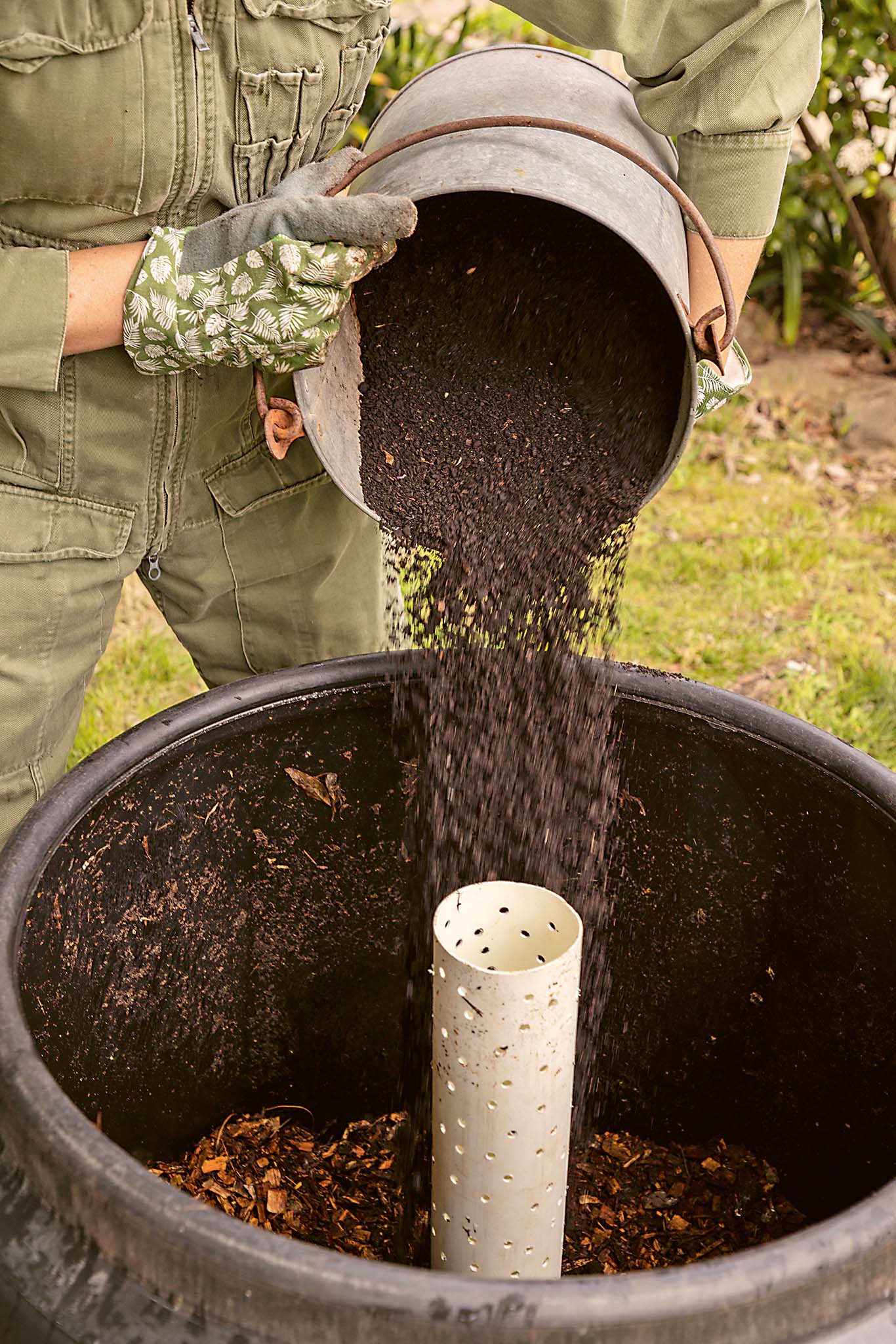
3. You’ll harvest your finished compost off the top of this carbon layer, so it will get used numerous times before it breaks down. This actually helps to re-seed your new compost with the beneficial bacteria from the previous batch. If this is your first batch of compost, then it’s a great idea to add a few handfuls of healthy garden soil, finished compost or a sprinkle or two of worm castings to act as a microbial inoculant. This helps to seed your compost and get the party started.
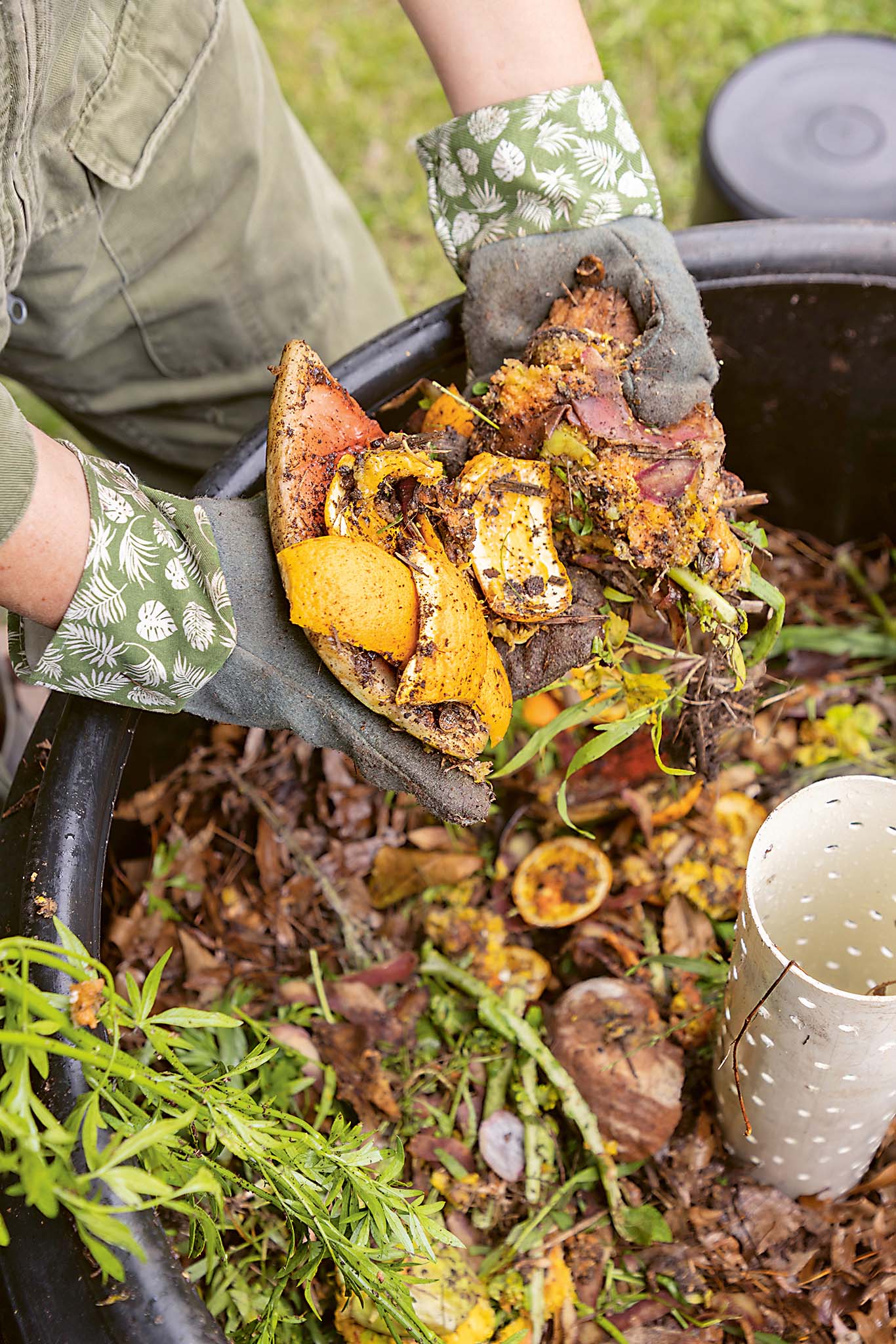
4. Now it’s time to gradually layer your greens (such as grass clippings – in layers no thicker than 3 centimetres – food scraps, seedless weeds, plant prunings, manure, coffee grounds, and so on) and browns (such as shredded paper, cardboard, aged woodchips/shavings/sawdust, autumn leaves, and so on). Keep the green layers thin and the brown layers more generous (for example, 5-centimetre green layers and 7-10-centimetre brown layers). It’s a good idea to use a compost turner to mix together your layers. Or you can insert a DIY ‘lung’ like this drilled PVC pipe into the centre of your bin and fill around it. Alternatively, you can premix the greens and browns in a container or wheelbarrow before adding them in, so there is direct contact between the nitrogen and carbon sources, as this helps the aerobic microbes work efficiently. This also prevents the centre of the green layer from becoming anaerobic and stinky.
5. As you add each new layer, you may need to add some water, too, as compost must be kept moist. The moisture from your juicy greens will likely provide almost enough water to keep the compost microbes happy during the cooler winter months. During the height of summer, however, it’s a good idea to wet your carbon materials before adding them to stop excessive evaporation and maintain the correct hydration. If you want to check whether your compost is thirsty or too wet, grab a handful of organic matter from the centre of your pile and give it a squeeze.
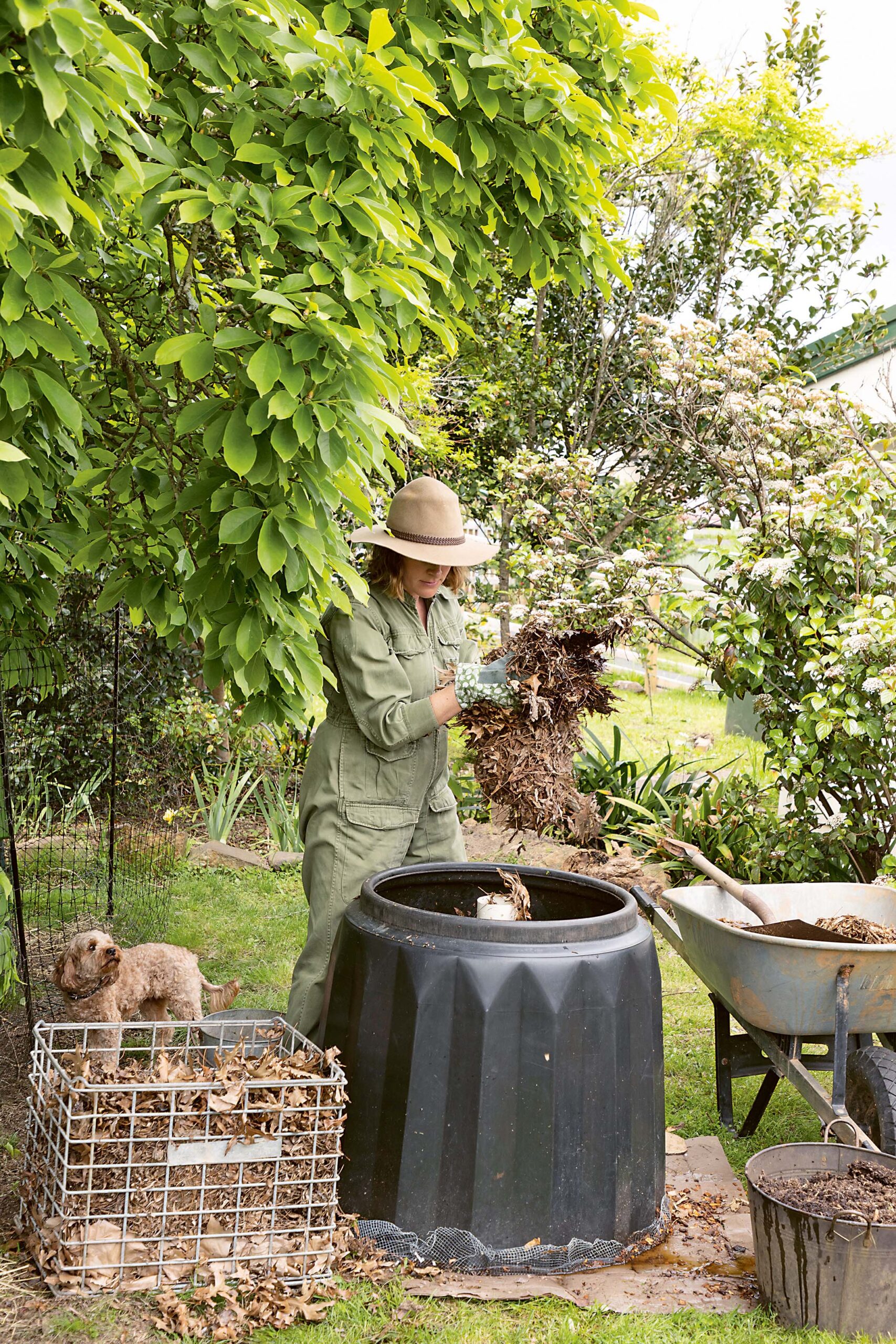
6. Always remember to add a layer of carbon materials to top off your scraps, even if you’ve premixed them with carbon, so your compost doesn’t start to attract flies. It’s useful to keep a container of carbon next to your compost, so you always have some on hand. Shredded autumn leaves are my favourite material for this job.
7. Each time you add more scraps to your compost, you may notice that the level has sunk rather than risen. This is normal – it can take several months for a slow compost bin to become full to the brim, thanks to the hungry microbes and compost critters. Once the compost bin is full, you can take a hands-off approach to the management and, for the most part, ignore the compost. Every now and then, check back in to see how it looks. Add a splash of water if it’s drying out or give it a turn if you haven’t layered it with sticks or added a DIY ‘lung’ to the centre.
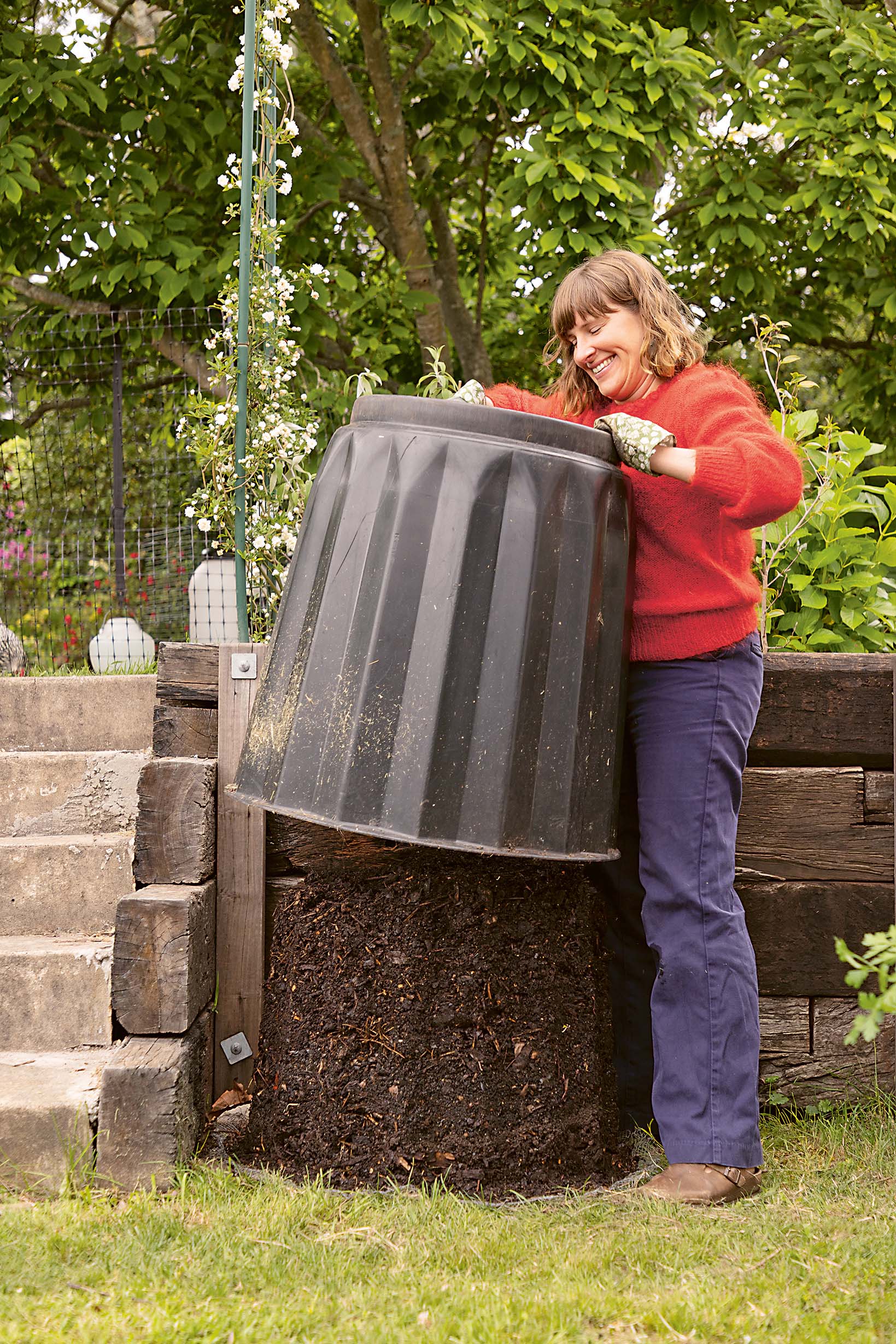
8. After six to 12 months, the bottom layer should be mature enough to use. The finished compost should be crumbly and dark brown – with no visible food scraps – and have an earthy smell. To harvest the bottom layer (if you’ve used a compost bin), lift off the bin and set it aside. Now move any organic matter that has not finished decomposing, by placing it in a wheelbarrow or tub. Start harvesting the beautifully crumbly black gold from the bottom of the compost. You’ll need to remove any larger sticks and put them back into your next batch of compost.
9. Keep harvesting until you hit the bottom foundation layer. Once all that’s left at the bottom of your bin or pile is a small amount of compost clinging to the woodchips and sticks, it’s time to pop your compost bin back on top. Then place the half-composted materials back into the bin, and now you’re ready to start the process all over again.
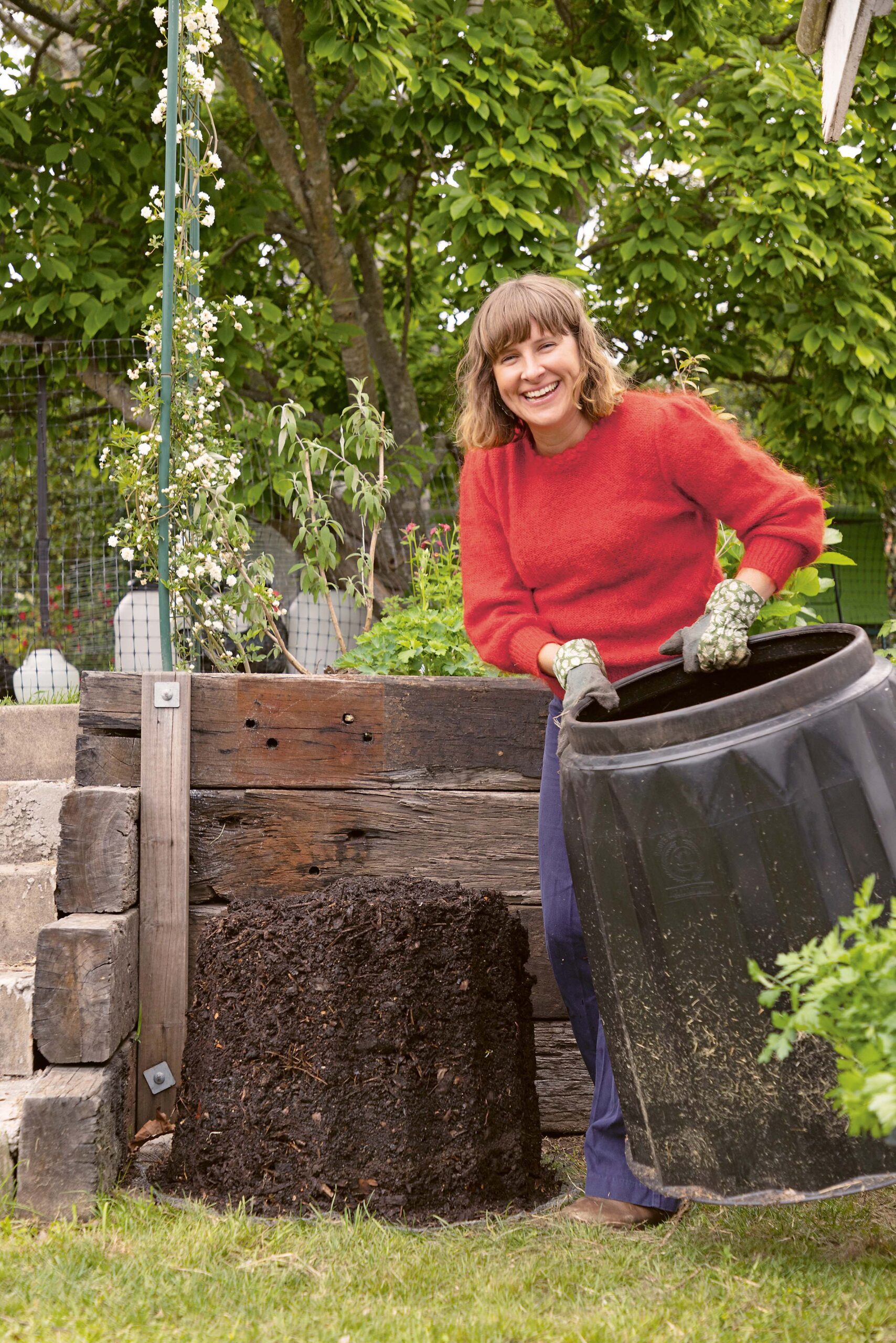
Speed Demons
If you want to get a little fancy, there are things you can add to your slow compost that will provide trace elements and speed up the process. These include compost activators** as well as homemade biochar, bonemeal or shell meal, and rock minerals or dusts. Don’t overdo these, otherwise your compost will become alkaline. **coffee grounds are great compost activators
Another method for speeding up decomposition is to turn your compost. Buy a corkscrew aerator or garden fork and give your compost a turn each time you add new scraps. If you don’t have the time, energy, ability or inclination to manually aerate your compost, that’s fine, too. You can create an open structure that will stop the contents of your pile or bin collapsing too much and becoming anaerobic by adding sticks, woodchips and chopped-up hedge prunings between your usual green and brown inputs. For a no-turn compost, it’s important to regularly add carbon of different sizes and textures (such as woodchips, sticks, straw/hay, cardboard and autumn leaves), as this creates pore spaces in your compost that circulate and capture oxygen.
